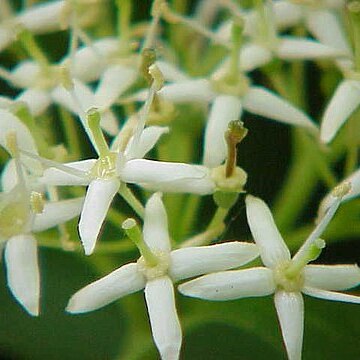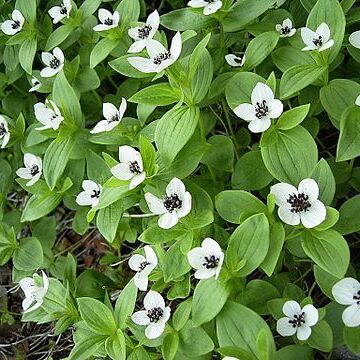Evergreen or deciduous (not in Australia), monoecious or dioecious (not in Australia) trees, shrubs or lianas (not in Australia), with 2-armed, stellate or glandular hairs. Leaves opposite or alternate, simple, entire to lobed, domatia often present, petiolate; stipules absent. Inflorescences terminal or axillary, cymose, paniculate or in heads surrounded by petal-like involucral bracts. Flowers bisexual or unisexual (not in Australia), actinomorphic. Calyx adnate to ovary, obsolete to distinct with 4–10 lobes. Petals 4–10, free or basally connate, valvate in bud. Stamens 4–40, alternating with petals (Cornus) or in a single whorl, surrounding an epigynous nectary disc (Alangium); filaments free, often barbate or villose (Alangium); anthers 2-locular, dehiscing by longitudinal slits. Ovary inferior, 1–4-carpellate; placentation apical; ovule 1 per locule; style simple with 2–3-lobed or capitate stigma or rarely short with 2 elongate stylodia. Fruit a drupe, sometimes fused into a fleshy compound fruit (Cornus), sometimes crowned by persistent calyx and disc (Alangium). Seeds with endosperm.
Herbs, shrubs, or trees, perennial, deciduous, synoecious [dioecious]; hairs unbranched or 2-armed (occasionally 1 arm absent). Leaves usually opposite, sometimes alternate, simple; stipules absent; petiole usually present, sometimes absent; blade margins entire; venation pinnate (eucamptodromous). Inflorescences axillary or terminal, cymes, umbels, or capitula. Flowers bisexual [unisexual]; perianth and androecium epigynous; hypanthium completely adnate to ovary; sepals 4(–5), distinct or slightly connate; petals 4(–5), distinct, valvate; nectary present, intrastaminal; stamens 4(–5), distinct, free; anthers dehiscing by longitudinal slits; pistil 1, [1–]2[–4]-carpellate, ovary inferior, [1–]2[–4]-locular, placentation apical; ovules 1 per locule, apotropous to epitropous; style 1; stigmas 2. Fruits drupes, rarely fused into a syncarp. Seeds 1(–2) per fruit.
Trees, shrubs or rarely perennial herbs. Leaves simple, alternate or opposite, entire or serrate; stipules usually absent. Flowers hermaphrodite or dioecious, in racemes, panicles, umbels, clusters of Cymules or compact heads. Calyx-tube adnate to the ovary; sepals 4–5 or absent. Petals 4–5 or rarely absent, imbricate or valvate. Stamens 4–5, alternating with the petals. Ovary inferior, usually 2-celled but often 1–4 (–10)-celled; ovules pendulous, one per loculus. Fruit a drupe or berry; embryo small in abundant endosperm
Flowers hermaphrodite or unisexual (then the plants usually monoecious or polygamodioecious), actinomorphic in cymes or panicles, umbels or rarely in capitula and then with large petal-like bracts
Stamens the same number as the petals and alternating with them, anthers 2-celled dehiscing laterally or rarely introrsely
Placentation usually axile, with 1 anatropous pendulous ovule in each loculus
Leaves opposite or less commonly alternate, simple, exstipulate
Petals 4–5 (rarely lacking), aestivation imbricate or valvate
Trees, shrubs, rarely perennial herbs or woody lianes
Style 1 or several rising from a glandular disk
Seed with copious endosperm and a small embryo
Fruit typically a drupe, sometimes a berry
Calyx-tube adnate to the ovary, sepals 4–5
Ovary inferior, with (1)2–4 locules
Ovules with 1 integument


